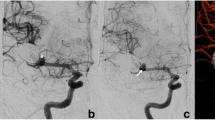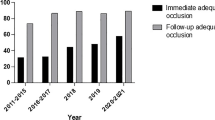Abstract
Background
Utilization of Woven EndoBridge (WEB) for treatment of intracranial aneurysms has increased due to increasing operator experience. We aimed to report our contemporary series of a North American center with the WEB, examining factors associated with occlusion rates.
Method
Consecutive patients (2019–2022) with intracranial aneurysms treated with WEB device were included. Through a univariate and multivariate analysis, independent predictors of adequate occlusion (RR1/RR2) were examined. Procedural and clinical results were reported.
Results
A total of 104 consecutive aneurysms/patients (25 men/79 women; median age, 63 years, IQR: 55–71) were treated with single-layer WEB-SL in our institution. Seventeen patients (16%) had a ruptured aneurysm. The median aneurysm dome size was 5.5 mm (IQR = 4.5–6.5), and the most common locations were AcomA (36/104 = 34.6%), MCA bifurcation (29/104 = 27.9%), and BT (22/104 = 21.2%). The rate of technical failure was 0.9%. The median intervention time was 32 min (IQR = 25–43). Overall, 8 (7.6%) cases needed additional interventions: 4 (3.8%) additional stenting, 3 cases (3.8%) of intravenous tirofiban infusion (because of the excessive WEB protrusion), and one case (0.9%) of additional coiling (need to complete the neck occlusion). At 12-month follow-up, 67 patients were available showing 59/67 (88%) and 6/67 (9%) of complete occlusion and neck remnant, respectively on dual-energy CTA. There were no cases necessitating retreatment. Ruptured presentation (OR = 0.09, 95% CI = 0.008–0.9, p = .024), undersized WEB (OR = 15, 95% CI = 1.2–50, p = .006), WEB shape change (OR = 0.07, 95% CI = 0.001–0.6, p = .05), aneurysm neck diameter (OR = 0.4, 95% CI = 0.2–0.9, p = .05), and angle between the parent artery and the aneurysm dome (OR = 0.2, 95% CI = 0.01–0.8, p = .008) were significantly associated with occlusion status (RR1-2) at follow-up. However, in the multivariate logistic regression, these factors did not reach the statistical significance. The overall rate of morbidity was 0.9%.
Conclusions
Our contemporary North American experience on consecutive intracranial aneurysms treated with WEB confirms the medium-term efficacy of this strategy, with low procedural time and morbidity. Further research is needed to demonstrate long-term occlusion rates.


Similar content being viewed by others
Data availability
Data are available upon reasonable request.
Abbreviations
- WEB:
-
Woven EndoBridge
- RR:
-
Raymond-Roy
- BT:
-
Basilar tip
- AcomA:
-
Anterior communicating artery
- MCA:
-
Middle cerebral artery
- ICA:
-
Internal carotid artery
References
Adeeb N, Dibas M, Diestro JDB, Phan K, Cuellar-Saenz HH, Sweid A, Lay SV, Guenego A, Aslan A, Renieri L, Sundararajan SH, Saliou G, Mohlenbruch M, Regenhardt RW, Vranic JE, Lylyk I, Foreman PM, Vachhani JA, Zupancic V, Hafeez MU, Rutledge C, Waqas M, Tutino VM, Rabinov JD, Ren Y, Schirmer CM, Piano M, Kuhn AL, Michelozzi C, Elens S, Starke RM, Hassan A, Salehani A, Brehm A, MohammedAli M, Jones J, Psychogios M, Spears J, Lubicz B, Panni P, Puri AS, Pero G, Griessenauer CJ, Asadi H, Siddiqui A, Ducruet A, Albuquerque FC, Du R, Kan P, Kalousek V, Lylyk P, Stapleton CJ, Boddu S, Knopman J, Aziz-Sultan MA, Limbucci N, Jabbour P, Cognard C, Patel AB, Dmytriw AA (2022) Comparing treatment outcomes of various intracranial bifurcation aneurysms locations using the Woven EndoBridge (WEB) device. J Neurointerv Surg. https://doi.org/10.1136/neurintsurg-2022-018694
Arthur AS, Molyneux A, Coon AL, Saatci I, Szikora I, Baltacioglu F, Sultan A, Hoit D, Delgado Almandoz JE, Elijovich L, Cekirge S, Byrne JV, Fiorella D, investigators W-IS, (2019) The safety and effectiveness of the Woven EndoBridge (WEB) system for the treatment of wide-necked bifurcation aneurysms: final 12-month results of the pivotal WEB Intrasaccular Therapy (WEB-IT) Study. J Neurointerv Surg 11:924–930. https://doi.org/10.1136/neurintsurg-2019-014815
Cagnazzo F, Ahmed R, Dargazanli C, Lefevre PH, Gascou G, Derraz I, Kalmanovich SA, Riquelme C, Bonafe A, Costalat V (2019) Treatment of wide-neck intracranial aneurysms with the Woven EndoBridge device associated with stenting: a single-center experience. AJNR Am J Neuroradiol 40:820–826. https://doi.org/10.3174/ajnr.A6032
Cagnazzo F, Ahmed R, Zannoni R, Dargazanli C, Lefevre PH, Gascou G, Derraz I, Riquelme C, Bonafe A, Costalat V (2019) Predicting factors of angiographic aneurysm occlusion after treatment with the Woven EndoBridge device: a single-center experience with midterm follow-up. AJNR Am J Neuroradiol 40:1773–1778. https://doi.org/10.3174/ajnr.A6221
Cagnazzo F, Marnat G, Ferreira I, Daube P, Derraz I, Dargazanli C, Lefevre PH, Gascou G, Riquelme C, Morganti R, Berge J, Gariel F, Barreau X, Costalat V (2021) Comparison of Woven EndoBridge device sizing with conventional measurements and virtual simulation using the Sim&Size software: a multicenter experience. J Neurointerv Surg 13:924–929. https://doi.org/10.1136/neurintsurg-2020-017060
Cognard C, Januel AC (2015) In Reply: WEB aneurysm treatment: occlusion stability and “compression.” Neurosurgery 77:E667-669. https://doi.org/10.1227/NEU.0000000000000881
Cortese J, Caroff J, Chalumeau V, Gallas S, Ikka L, Moret J, Sabuzi F, Popescu SD, Ozanne A, Grimaldi L, Mihalea C, Spelle L (2022) Determinants of cerebral aneurysm occlusion after embolization with the WEB device: a single-institution series of 215 cases with angiographic follow-up. J Neurointerv Surg. https://doi.org/10.1136/neurintsurg-2022-018780
Dmytriw AA, Dibas M, Ghozy S, Adeeb N, Diestro JDB, Phan K, Cuellar-Saenz HH, Sweid A, Lay SV, Guenego A, Renieri L, Al Balushi A, Saliou G, Mohlenbruch M, Regenhardt RW, Vranic JE, Lylyk I, Foreman PM, Vachhani JA, Zupancic V, Hafeez MU, Rutledge C, Waqas M, Tutino VM, Rabinov JD, Ren Y, Schirmer CM, Piano M, Kuhn AL, Michelozzi C, Elens S, Starke RM, Hassan A, Salehani A, Sporns P, Jones J, Psychogios M, Spears J, Lubicz B, Panni P, Puri AS, Pero G, Griessenauer CJ, Asadi H, Stapleton CJ, Siddiqui A, Ducruet AF, Albuquerque FC, Du R, Kan P, Kalousek V, Lylyk P, Boddu S, Tjoumakaris S, Knopman J, Aziz-Sultan MA, Limbucci N, Jabbour P, Cognard C, Patel AB (2022) The Woven EndoBridge (WEB) device for the treatment of intracranial aneurysms: ten years of lessons learned and adjustments in practice from the WorldWideWEB Consortium. Transl Stroke Res. https://doi.org/10.1007/s12975-022-01072-x
Fiorella D, Molyneux A, Coon A, Szikora I, Saatci I, Baltacioglu F, Sultan A, Arthur A, Investigators W-IS (2017) Demographic, procedural and 30-day safety results from the WEB Intra-saccular Therapy Study (WEB-IT). J Neurointerv Surg 9:1191–1196. https://doi.org/10.1136/neurintsurg-2016-012841
Lescher S, du Mesnil de Richemont R, Berkefeld J (2016) Woven Endobridge (WEB) device for endovascular treatment of complex unruptured aneurysms-a single center experience. Neuroradiology 58:383–390. https://doi.org/10.1007/s00234-016-1641-x
Limbucci N, Leone G, Rosi A, Consoli A, Renieri L, Laiso A, Cirelli C, Wlderk A, Nappini S, Mangiafico S (2018) Endovascular treatment of unruptured intracranial aneurysms by the Woven EndoBridge Device (WEB): are there any aspects influencing aneurysm occlusion? World Neurosurg 109:e183–e193. https://doi.org/10.1016/j.wneu.2017.09.136
Pierot L (2015) Letter: WEB aneurysm treatment: occlusion stability and “compression.” Neurosurgery 77:E666-667. https://doi.org/10.1227/NEU.0000000000000880
Pierot L, Moret J, Barreau X, Szikora I, Herbreteau D, Turjman F, Holtmannspotter M, Januel AC, Costalat V, Fiehler J, Klisch J, Gauvrit JY, Weber W, Desal H, Velasco S, Liebig T, Stockx L, Berkefeld J, Molyneux A, Byrne J, Spelle L (2018) Safety and efficacy of aneurysm treatment with WEB in the cumulative population of three prospective, multicenter series. J Neurointerv Surg 10:553–559. https://doi.org/10.1136/neurintsurg-2017-013448
Roy D, Milot G, Raymond J (2001) Endovascular treatment of unruptured aneurysms. Stroke 32:1998–2004
Sahnoun M, Soize S, Manceau PF, Gelmini C, Pierot L (2022) Intracranial aneurysm treatment with WEB and adjunctive stent: preliminary evaluation in a single-center series. J Neurointerv Surg 14:164–168. https://doi.org/10.1136/neurintsurg-2021-017379
Spelle L, Herbreteau D, Caroff J, Barreau X, Ferre JC, Fiehler J, Januel AC, Costalat V, Liebig T, Bourcier R, Mohlenbruch M, Berkefeld J, Weber W, Mihalea C, Ikka L, Ozanne A, Cognard C, Narata AP, Bibi RE, Gauvrit JY, Raoult H, Velasco S, Buhk JH, Chalumeau V, Bester M, Desal H, du Mesnil de Rochemont R, Bohner G, Fischer S, Biondi A, Grimaldi L, Moret J, Byrne J, Pierot L (2022) CLinical Assessment of WEB device in Ruptured aneurYSms (CLARYS): results of 1-month and 1-year assessment of rebleeding protection and clinical safety in a multicenter study. J Neurointerv Surg 14:807–814. https://doi.org/10.1136/neurintsurg-2021-017416
van Rooij S, Sprengers ME, Peluso JP, Daams J, Verbaan D, van Rooij WJ, Majoie CB (2020) A systematic review and meta-analysis of Woven EndoBridge single layer for treatment of intracranial aneurysms. Interv Neuroradiol 26:455–460. https://doi.org/10.1177/1591019920904421
Author information
Authors and Affiliations
Corresponding author
Ethics declarations
Ethical approval
This article does not contain any studies with human participants performed by any of the authors.
Conflict of interest
Dr. Cagnazzo and Dr. Cloft certify that they have no affiliations with or involvement in any organization or entity with any financial interest (such as honoraria; educational grants; participation in speakers’ bureaus; membership, employment, consultancies, stock ownership, or other equity interest; and expert testimony or patent-licensing arrangements), or non-financial interest (such as personal or professional relationships, affiliations, knowledge, or beliefs) in the subject matter or materials discussed in this manuscript. Dr. Brinjikji reports being a consultant for Medical Director for MIVI, Medtronic, Stryker, Microvention, Asahi, Balt, and Imperative Care. Dr. Lanzino reports being a consultant for Covidien/Medtronic.
Additional information
Publisher's note
Springer Nature remains neutral with regard to jurisdictional claims in published maps and institutional affiliations.
Rights and permissions
Springer Nature or its licensor (e.g. a society or other partner) holds exclusive rights to this article under a publishing agreement with the author(s) or other rightsholder(s); author self-archiving of the accepted manuscript version of this article is solely governed by the terms of such publishing agreement and applicable law.
About this article
Cite this article
Cagnazzo, F., Cloft, H.J., Lanzino, G. et al. WEB (Woven EndoBridge) device for intracranial aneurysm treatment: technical, radiological, and clinical findings in a consecutive North American cohort. Acta Neurochir 165, 2077–2086 (2023). https://doi.org/10.1007/s00701-023-05668-6
Received:
Accepted:
Published:
Issue Date:
DOI: https://doi.org/10.1007/s00701-023-05668-6




